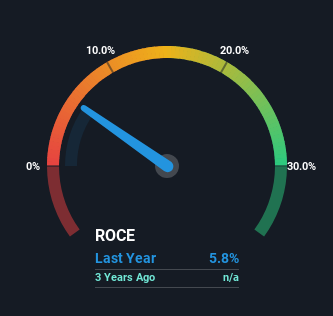- Hong Kong
- /
- Trade Distributors
- /
- SEHK:9878
Investors Met With Slowing Returns on Capital At Huitongda Network (HKG:9878)
What trends should we look for it we want to identify stocks that can multiply in value over the long term? Firstly, we'd want to identify a growing return on capital employed (ROCE) and then alongside that, an ever-increasing base of capital employed. Ultimately, this demonstrates that it's a business that is reinvesting profits at increasing rates of return. In light of that, when we looked at Huitongda Network (HKG:9878) and its ROCE trend, we weren't exactly thrilled.
Return On Capital Employed (ROCE): What Is It?
If you haven't worked with ROCE before, it measures the 'return' (pre-tax profit) a company generates from capital employed in its business. The formula for this calculation on Huitongda Network is:
Return on Capital Employed = Earnings Before Interest and Tax (EBIT) ÷ (Total Assets - Current Liabilities)
0.058 = CN¥562m ÷ (CN¥30b - CN¥21b) (Based on the trailing twelve months to June 2024).
Therefore, Huitongda Network has an ROCE of 5.8%. Even though it's in line with the industry average of 5.9%, it's still a low return by itself.
View our latest analysis for Huitongda Network

Above you can see how the current ROCE for Huitongda Network compares to its prior returns on capital, but there's only so much you can tell from the past. If you'd like to see what analysts are forecasting going forward, you should check out our free analyst report for Huitongda Network .
How Are Returns Trending?
Things have been pretty stable at Huitongda Network, with its capital employed and returns on that capital staying somewhat the same for the last two years. This tells us the company isn't reinvesting in itself, so it's plausible that it's past the growth phase. So don't be surprised if Huitongda Network doesn't end up being a multi-bagger in a few years time.
Another thing to note, Huitongda Network has a high ratio of current liabilities to total assets of 68%. This can bring about some risks because the company is basically operating with a rather large reliance on its suppliers or other sorts of short-term creditors. While it's not necessarily a bad thing, it can be beneficial if this ratio is lower.
The Key Takeaway
In a nutshell, Huitongda Network has been trudging along with the same returns from the same amount of capital over the last two years. And investors appear hesitant that the trends will pick up because the stock has fallen 37% in the last year. All in all, the inherent trends aren't typical of multi-baggers, so if that's what you're after, we think you might have more luck elsewhere.
If you want to continue researching Huitongda Network, you might be interested to know about the 1 warning sign that our analysis has discovered.
While Huitongda Network may not currently earn the highest returns, we've compiled a list of companies that currently earn more than 25% return on equity. Check out this free list here.
Valuation is complex, but we're here to simplify it.
Discover if Huitongda Network might be undervalued or overvalued with our detailed analysis, featuring fair value estimates, potential risks, dividends, insider trades, and its financial condition.
Access Free AnalysisHave feedback on this article? Concerned about the content? Get in touch with us directly. Alternatively, email editorial-team (at) simplywallst.com.
This article by Simply Wall St is general in nature. We provide commentary based on historical data and analyst forecasts only using an unbiased methodology and our articles are not intended to be financial advice. It does not constitute a recommendation to buy or sell any stock, and does not take account of your objectives, or your financial situation. We aim to bring you long-term focused analysis driven by fundamental data. Note that our analysis may not factor in the latest price-sensitive company announcements or qualitative material. Simply Wall St has no position in any stocks mentioned.
About SEHK:9878
Huitongda Network
An industrial internet company, provides digital technologies and supply chain capabilities in China.
Flawless balance sheet with moderate growth potential.
Market Insights
Community Narratives



